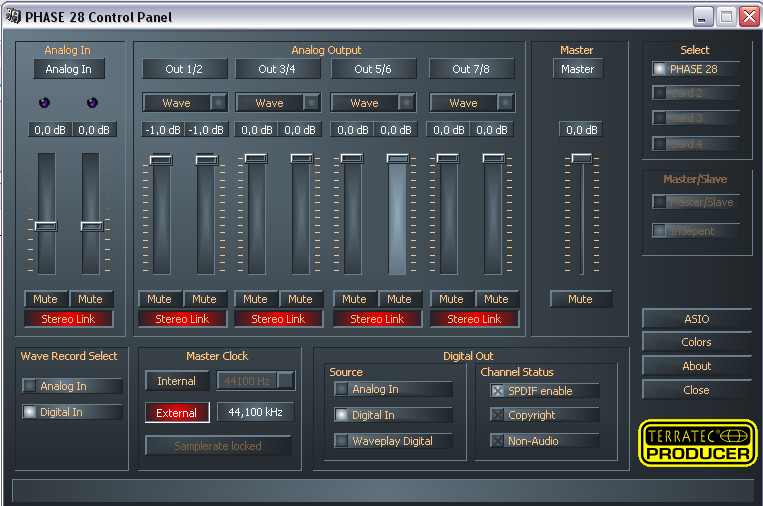Hello,
I would like to transfer my music recorded on DAT to my PC.
I have a sound card with a coaxial SPDIF input (a Terratec Phase 28). Everything seems to be work fine, but I have a doubt : when I had recorded a CD on my DAT, also using an SPDIF cable, my DAT recorder automatically add the track number, stop to record at the end, and so on.
Now with Audacity I must start manually to record, stop it, … aboslutely as a analog recording session. I just want to be sure that it is not the case, and that I’m not going to record a digital stream converted to an analog one and converted another time to a digital one ! Is there any possibility to better use the SPDIF stream with Audacity ?
John
I think this is an issue entirely concerning the hardware and driver. Audacity just records the data that is sent to it and has no control whatsoever over how your sound card handles the audio data. Audacity receives digital data from the sound card via the sound card drivers, so as far as Audacity is concerned it is all digital.
Whether your sound card pushes the SPDIF data through its converters, or buffers it internally, or does anything else, is not something that Audacity has anything to do with. The main advantage of using the SPDIF input is not so much to do with how the sound card handles the data, but the fact that the data does not need to go through analogue circuitry when coming out of the DAT, or going into the sound card. It is the analogue I/O circuitry and its associated noise/distortion that is being bypassed. The actual transfer from the DAT to the sound card will be bit perfect (or at least very close). Any manipulation of the data within your sound card is likely to be very high quality, though not necessarily bit perfect.
You are obviously try to get as near as possible to “bit perfect” copies, so one thing that you may want to pay some attention to is to ensure that the data format is consistent throughout the signal chain. SPDIF generally uses 20 bit data at 44.1 or 48kHz, although some hardware can support 24 bit data. 16 bit data is accommodated by setting the 4 unused bits to zero. If 24 bit data is received by a sound card that only supports up to 20 bit, then the extra 4 bits are ignored.
DAT machines generally use 48kHz sample rate, so you should make sure that everything, including Audacity are set to 48kHz. Some sound cards have a fixed sample rate that they use internally and will resample in hardware any data that is at a different sample rate. If possible you will want all of your hardware to be using the same sample rate so as to avoid the need for resampling. If supported by your hardware, you should set the sound card and the DAT to use the same wordclock.
I guess the real issue is, if SPDIF sounds better than the analogue input, then you should use it.
(If you have a SCSI DAT drive in your computer you can dump the digital data directly to a WAV file - this is bit perfect, but I’ve not seen any SCSI DAT drives for years, and they were very expensive).
Actually I’m using the external clock, I think it’s the better way to handle this problem ![]()

We may be the only company you’ve ever seen that’s using a DAT machine correctly.
It’s mounted in the racks in the equipment room and it gets its SMPTE genlock signal from the same generator that’s driving all the other videotape machines and editors. The digital outputs are fully AES/EBU compliant and go into the audio routing switcher along with all the other audio connections in the building. AES/EBU and SPDIF are not the same thing, but they’re close. One will always play the other, but it’s only one way and I forget the direction.
The serial connection will plug right into any edit command console. We use a very old Sony field editor in the racks, but the DAT machine will assign directly into any of the Avids, Final Cut machines, Inferno’s or Flame suites.
Sony was very aggressive in designing these machines to be completely compatible with grown-up broadcast equipment (48000, 16 bit, SMPTE TimeCode) and they succeeded. However, in the same sense that you won’t be dragging a D1 digital video machine home with you any time soon, most DAT transfers, probably in the world, happen through the headphone connection.
I don’t know anyone whose managed a digital transfer at home without a click every so often as the sample rates drift past each other. The larger machines do have internal locks and you can do transfers in the field that way, but it’s not recommended.
I have a very old tiny portable DAT machine that I’m sure no longer works. That’s scary.
Koz
I am new in this field; but I would like to record several AES/EBU or S/PDIF streams, process them (mix) with Audacity, and then export the result as an AES/EBU or S/PDIF stream.
I guess, I will need a sound card with digital I/O (would a Terratec Phase 28 do it?)
Can I record the digital stream directly via Audacity? Will the Timecode (SMPTE/EBU) information be preserved in the recording?
Can Audacity recognize the Timecode in th way that the different recordings can be time-aligned?
Can I use Audacity to export the edited music and preserve the Timecode while exporting?
Any hint is welcome!
Thanks
Wichard